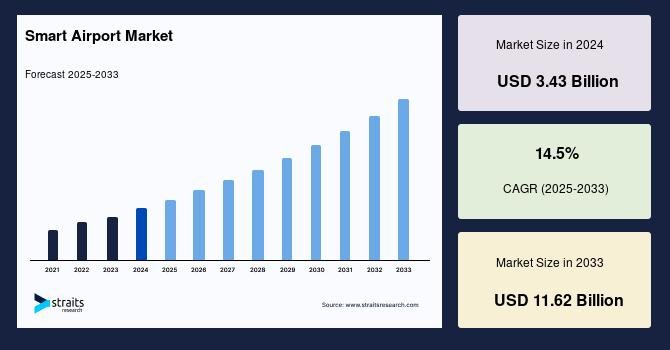As per Straits Research, the global smart airport market size was valued at USD 3.43 billion in 2024 and is projected to reach USD 11.62 billion by 2033, at a CAGR of 14.5% during the forecast period (2025-2033).The global smart airport market is growing rapidly, driven by technological advancements, rising passenger traffic, operational efficiency improvements, and sustainability initiatives.
Explore more smart airport market report insights: https://straitsresearch.com/report/smart-airport-market
Smart Airport Market Growth Driver
The global smart airport market is witnessing significant growth, driven by several key factors. Technological advancements are at the forefront, with airports increasingly adopting IoT, AI, machine learning, and biometric systems to optimize operations. These technologies enable seamless passenger experiences, real-time asset monitoring, predictive maintenance, and efficient resource management. Automation in baggage handling, check-in, and security processes reduces operational costs while improving throughput, and AI-driven analytics help predict passenger flow and manage peak traffic effectively.
Increasing passenger traffic is placing pressure on airport infrastructure, prompting the adoption of smart solutions to reduce congestion and waiting times. Automated kiosks, mobile check-ins, facial recognition, and smart boarding gates enhance the travel experience and provide real-time updates. Operational efficiency is further improved through integrated security systems, automated baggage handling, and AI-enabled air traffic management, reducing human error and optimizing resource allocation. Additionally, sustainability initiatives are driving investments in energy-efficient infrastructure, waste management, and smart facility systems to minimize carbon footprints and comply with environmental regulations.
Market Segmentation
The global smart airport market shows notable growth across technology, application, and location segments. By technology, the communication system segment is projected to grow the fastest, as airports increasingly collect passenger data to provide real-time information on flight status, nearby retail, taxi and bus services, and traffic updates. This data-driven approach enhances passenger experience and operational efficiency.
By application, the aeronautical operations segment includes gate and noise management, while non-aeronautical operations cover supply chain management and advanced transport services. Noise management leads the market as airports implement programs to reduce aircraft noise during take-offs and landings, such as Toronto Pearson Airport’s Noise Management Action Plan. By location, the terminal side segment dominates, with kiosks and digital displays guiding passengers and providing real-time flight and location information across airport terminals.
Request a sample to access more segmental analysis: https://straitsresearch.com/report/smart-airport-market/request-sample
Regional Analysis
The North American smart airport market dominates due to substantial investments in smart infrastructure, strong technological adoption, and the presence of major international airports. Airports in the U.S. and Canada are leveraging AI, IoT, and biometrics to streamline operations and enhance passenger experience, supported by initiatives from the Federal Aviation Administration (FAA) and Canadian airport authorities that promote digital transformation and innovation.
Europe focuses on sustainability and operational excellence, with airports in the UK, Germany, and France implementing energy-efficient systems, green mobility solutions, and AI-based analytics for resource planning. The Asia-Pacific region is experiencing the fastest adoption of smart airport solutions, driven by rapid urbanization, growing air travel demand, and government modernization initiatives in countries like China, India, and Japan. Meanwhile, the Middle East invests heavily in luxury passenger experiences and advanced security, exemplified by Dubai and Doha, while African airports are gradually embracing automation and smart technologies to enhance efficiency and meet rising passenger demand.
List of key players in Smart Airport Market
Amadeus IT Group SA
Cisco Systems, Inc.
Collins Aerospace
Honeywell International Inc.
Huawei Technologies Co., Ltd.
IBM Corporation
Indra Sistemas SA
Sabre Corp.
Siemens AG
SITA
Thales Group
Buy full report: https://straitsresearch.com/report/smart-airport-market/request-sample
Conclusion
The smart airport market is undergoing a significant transformation, driven by technological innovation, rising passenger traffic, and increasing demand for operational efficiency and sustainability. Airports worldwide are integrating AI, IoT, biometrics, and automation to enhance passenger experiences, reduce operational costs, and achieve environmental goals.
More Related Reports:
Airport Security Market: https://straitsresearch.com/report/airport-security-market
Airport Retailing Market: https://straitsresearch.com/report/airport-retailing-market
Airport Retailing Market: https://straitsresearch.com/report/airport-retailing-market
Airport Automation Market: https://straitsresearch.com/report/airport-automation-market
Advanced Airport Technologies Market: https://straitsresearch.com/report/advanced-airport-technologies-market
Contact Us
Office 515 A, Amanora Chambers,
Amanora Park Town, Hadapsar,
Pune 411028, Maharashtra, India.
+1 646 905 0080 (U.S.)
+91 8087085354 (India)
+44 203 695 0070 (U.K.)
About Us
For over a decade, Straits Research has been a trusted partner to more than 2,000 small and large enterprises, empowering senior leaders and decision-makers with actionable intelligence to navigate complex markets. Our structured syndicate reports, published year-round, cover critical sectors such as chemicals, materials, food and beverage, healthcare, pharmaceuticals, automotive, technology, aerospace, and defense. Combined with our custom research tailored to client-specific needs, we deliver insights that drive business progress and informed decision-making.
This release was published on openPR.













